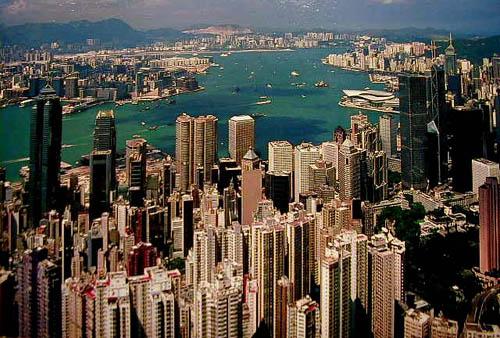

Like sentinels the skylines of Hong Kong Island and Kowloon watch each other across the harbor. With high peaks looming behind them, built on a narrow strip of land that encroaches upon the mountain slopes, Hong Kong's skyscrapers look crowded. Standing amongst them, we were surprised at the harmony and beauty that city planners have achieved. Parks, plazas with landscaped terraces, and fountains are interspersed amongst genius architecture. Many different colors of mirrored glass reflect the images of neighboring structures. Some of the world's most beautiful modern buildings stand in this huge expanse of concrete, steel and glass. The return to China's rule has not effected Hong Kong's commercial significance, pulsating business and ever-growing landscape. We always wanted to walk the streets of this gigantic city.


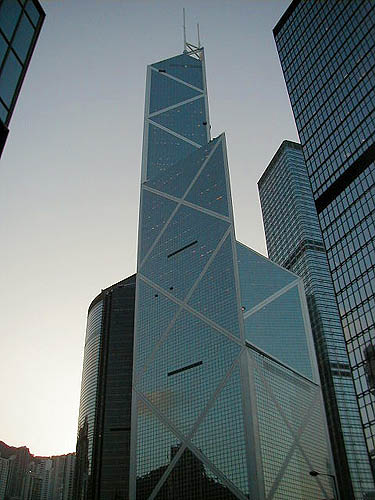
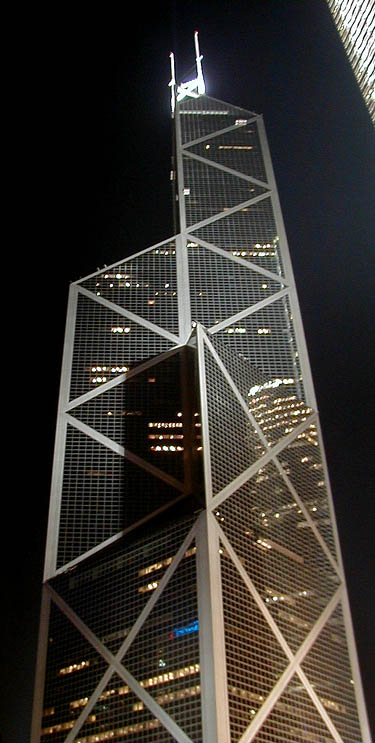
We arrived at the spectacular new Hong Kong airport, another masterpiece of modern architecture. Due to limited land resources, a small island was flattened and expanded to house this huge, shiny complex. To link it with the main land the longest expansion bridge in the world had to be constructed. The Airport Express, a beautiful high speed train, leaves right from the baggage claim level. With limited stops we were quickly delivered to Kowloon, the location of our hotel. It was one of the most pleasant airport experiences I have ever had.
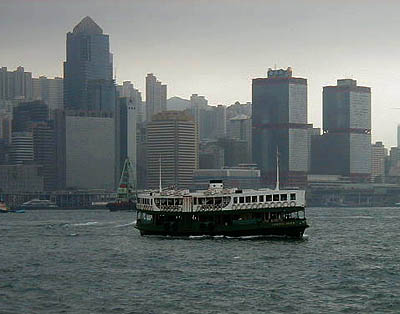 A complete public transportation system, including subway, bus, train and boat, allowed us to travel to all destinations in a clean, timely and inexpensive fashion. From our hotel in Kowloon we walked one mile on busy Nathan Road to the harbor terminal. From there we could catch ferry boats to Hong Kong and many other destinations.
A complete public transportation system, including subway, bus, train and boat, allowed us to travel to all destinations in a clean, timely and inexpensive fashion. From our hotel in Kowloon we walked one mile on busy Nathan Road to the harbor terminal. From there we could catch ferry boats to Hong Kong and many other destinations.
On our first day we took the famous Star Ferry (right) to Hong Kong island and strolled through the city and the botanical garden. In addition to interesting plants the gardens included a small zoo with monkeys, birds and a pair of jaguars, most of them endangered species. The orangutans and gibbons were especially boisterous, swinging around their cages hooting and howling. We marveled at the colorful feathers of many rare birds like the red ibis. From there we walked to the one-mile-long Escalator, a Hong Kong landmark. It starts in the shopping and business center and travels to the residential areas above the city. We spend the afternoon in the Hong Kong Art Museum with three separate exhibitions: bronze artifacts from an ancient Chinese kingdom, calligraphy and scroll paintings.
Just walking the streets was an adventure. Many avenues are lined with street markets, and vendors of all types cram their goods into tiny stalls. Meats of varieties I didn't care to know about, hung on hooks out in the open. Dried food shops filled with barrels of unidentifiable products, mostly sea creatures, equally amazed and alarmed us. Smells sometimes pleasant, but mostly violent engulfed us constantly. Finding inexpensive and appetizing food turned into a constant problem. Dishes like shark fin and birds nest soup had price tags of one hundred US dollars. Simple Chinese meals, like sweet and sour pork, available in the States for around seven dollars, cost 15 to 20 dollars in Hong Kong. I tried a pork and rice dish from a small cooking establishment. The pork was fatty and full of cartilage. Very disappointing!
On Sunday we visited Hong Kong Park, set beautifully among the city's giant glass towers. Waterfalls fell into an enchanting pond filled with colorful fish. Interesting fountains and sculptures, and a variety of trees and shrubs adorned the landscape. The grounds include the wedding registry and the Tea Museum. Wedding parties posed throughout the park, then walked on to the next photo spot. At the Tea Museum we viewed ancient Chinese tea vessels, and learned about the history of the tea ceremony. The next day we visited the flower and bird markets. The latter was unusual, and perhaps even a bit offensive. Parakeets, cockatiels, myna birds, small parrots, even sparrows and finches were crammed into tiny cages. Large beautiful blue and gray macaw parrots, cockatoos and galahs were chained to their stands and acted very disturbed. The cages for small birds were handmade of wood and stained in beautiful, antique brown. I would have bought a cage without the bird. We came away feeling sorry for the birds, most of which we had observed living in the wild in Australia. That afternoon our friend Chris arrived from Germany. She traveled with us in Hong Kong, Beijing and Thailand. We truly enjoyed sharing these experiences with her!
For breakfast, we took Chris to our favorite French cafe we had found in the waterfront shopping mall. They served the normal food and delicious coffee that agreed with our pampered pallets. After, we rode boats and buses to an interesting tourist spot called Tiger Balm Gardens, created by a famous Hong Kong philanthropist. Artificial caves, mountains and creatures, made of fiberglass and painted in vivid colors, attempt to describe Chinese history and mythology. From there we took one of the famous double-decker trams back to the city center. On all of our double-decker bus and tram rides we succeeded to sit in front of the forward window on the top level. It's as good as any roller coaster ride. We owe Chris for this tip!
Later, we went to Aberdeen. The two dollar, twenty mile bus ride took us up and down the steep roads and allowed views onto smaller islands around Hong Kong. Guide books promised the Aberdeen harbor filled with junks, traditional Chinese sail boats. As soon as we reached the boardwalk, old Chinese ladies began to stalk us soliciting sampan rides. A sampan is the equivalent of a small motorized junk. As we reached the end of the walkway, we selected a cute older woman hailing us from her sampan for a ride around the harbor. Unfortunately, the old style sailing junks belong to days past. The harbor was crowded with wooden motorized vessels that function both as fishing boats and homes for the whole family. We did see one beautiful old junk, but it wasn't under sail. For dinner we ate at the famous floating restaurant Jumbo in the same harbor. It was one of the best meals we ate in Hong Kong. On the way back to our hotel I bought the digital camera.
The guide book recommended a restored ancient walled village. Our hotel manager was not familiar with the location, but directed us to a different site of a walled village. When we arrived we were surprised to find people still living there in poor, dirty conditions. We didn't stay long, and proceeded to visit Buddhist temples for the rest of the day. The Chinese are serious about exercising their religion, and all temples are in perfect condition:
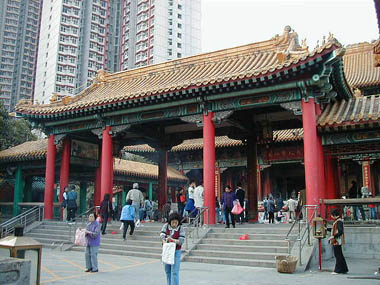
 Burning incense sticks
Burning incense sticks
Overcast weather continued throughout the week. Low gray clouds thickened the haze of Hong Kong's air pollution. When the sun appeared during our temple visits we decided to seize the clear moment and visit The Peak. Windy walking paths lead to this famous lookout. We decided to take the Peak Tram that struggles up the steep mountain slope. It was a beautiful, clear evening with spectacular views.
Intensified scrutiny of our travel guide revealed the location and directions for the restored 150-year-old walled village. Furthermore, we determined to combine that visit with a trip to Lantau Island to see the Giant Buddha (78 feet high, below left) and Po Lin Monastery (below right). We skipped breakfast to get an early start. A high wall surrounds the village of about 30 rooms once inhabited by one extended family or clan. The perfectly restored rooms and gathering halls contained original furnishings and artifacts that enhanced their authenticity. Interesting exhibits of paintings and descriptions improved our appreciation of past life in the walled village, but certainly romanticized the reality we had observed the other day. We were a bit disappointed to find the monastery and giant buddha complex on Lantau Island's mountains so commercialized. Besides many stands selling souvenirs, sausages and sodas, there was a restaurant inside the giant buddha. The island's high rugged peaks were hidden from our view by thick clouds. We gave up on plans to hike to Lantau Peak.
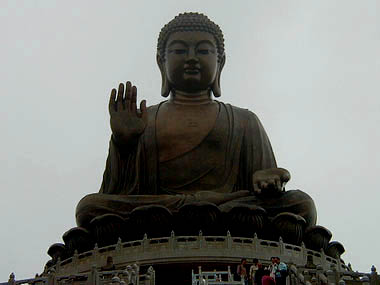
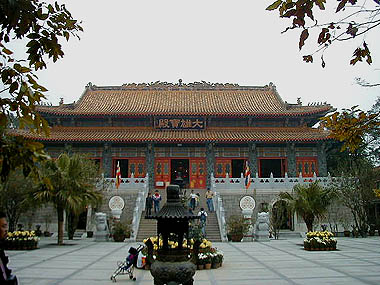
We continued our bus travels on Lantau Island and visited a tiny seaside village called Tao (pronounced Tah O). We found the small, dirty village canals crowded with stilted houses exhibiting the most innovative architecture:

The front facades of these shacks, facing the village path, were covered with silver sheet metal. Tiny rooms were stacked up on top of each other and averaged ten square feet. The river running through the village also functioned as a universal garbage dump. One certainly appreciates the luxury and cleanliness we are surrounded with every day after observing the tragic living conditions in such places. Still, the people seem happy and content with their situation. We never encountered any grim or aggressive expressions.
Friday was our last day, and I was exhausted. I took the day off to relax and work on the web site. Chris and Elke returned to Hong Kong island, once again rode the escalator, and strolled along Cat Street. The streets of this old district are lined with many beautiful antique shops. Street vendors sell souvenir paraphernalia, and tiny stores, more like holes in the wall, are stuffed with all kinds of old junk. They also visited two small neighborhood temples filled with the intense smell and smoke of incense spirals. They welcomed the fragrance of Chinese teas inside a fine tea shop, where they enjoyed the presentation and practice of a relaxing, traditional tea ceremony, and the unusual taste of two exotic blossoms.
We were ready to leave the dirty air, the loud streets with their huge, colorful neon signs, the honking traffic, the rushing people, the stinging food smells, the life of a crazy, crowded city. But many fascinating pictures will remain in our memory: fabulous architecture; endless, sparkling shopping centers; mysterious, colorful temples; the exciting bustle of street markets; remarkable Chinese art and history. We certainly enjoyed the ultimate introduction to the pace and colors of a large Asian city.